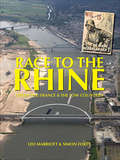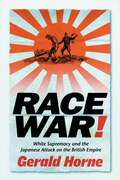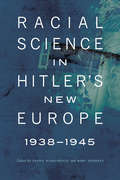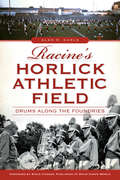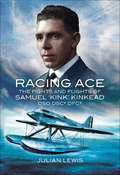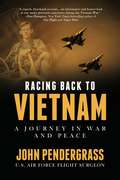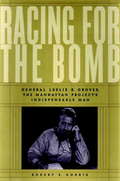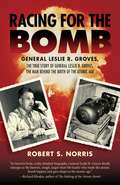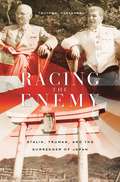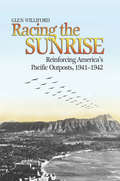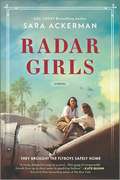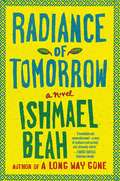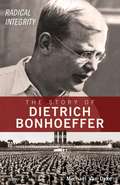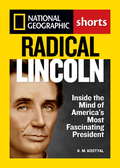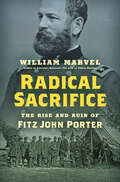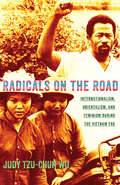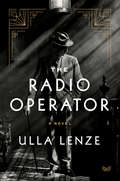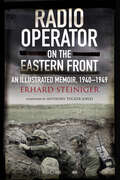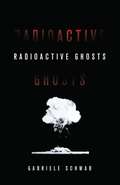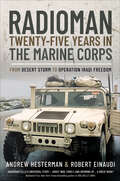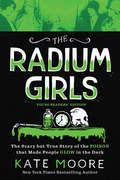- Table View
- List View
Race to the Rhine: Liberating France and the Low Countries 1944-45 (Then And Now Ser.)
by Simon Forty Leo MarriottTravel across the battlefields of WWII with this beautiful book combining historical images, full-color aerial photography, and informative text.In June, 1944, Allied forces invaded Nazi-occupied France, beginning a sweep of fierce battles that would eventually liberate Western Europe. With aerial photography, historic images, maps, and other illustrations, Race to the Rhine brings readers to the fateful grounds where men sacrificed their lives for freedom.The destruction of German forces in Normandy’s Falaise pocket was a decisive victory: by September, British troops were in Ghent and Liege; Canadian forces liberated Ostend, and in northeast France, Patton’s Third Army was moving rapidly to the German border. The liberation of the Low Countries would not prove as straightforward, however. Operation Market Garden—Montgomery’s brave thrust toward the Rhine at Arnhem—ended in failure with over 6,000 paratroopers captured.In late October, belated operations began to clear the Scheldt Estuary and open the port of Antwerp to the Allies. Belgium was almost free of the Nazi yoke and the Netherlands looked likely to be cleared before Christmas. Then, on December 16, came a major German counter-offensive in the Ardennes. It turned out to be Hitler’s last try: the American defenders held, and in the spring the Rhine was finally gained.Perfect for the armchair traveler or for those who want a historic guide as they visit significant sites, Race to the Rhine supplies essential information on the places that best represent the battles today.
Race War!: White Supremacy and the Japanese Attack on the British Empire
by Gerald HorneJapan's lightning march across Asia during World War II was swift and brutal. Nation after nation fell to Japanese soldiers. How were the Japanese able to justify their occupation of so many Asian nations? And how did they find supporters in countries they subdued and exploited? Race War! delves into submerged and forgotten history to reveal how European racism and colonialism were deftly exploited by the Japanese to create allies among formerly colonized people of color. Through interviews and original archival research on five continents, Gerald Horne shows how race played a key--and hitherto ignored--;role in each phase of the war.During the conflict, the Japanese turned white racism on its head portraying the war as a defense against white domination in the Pacific. We learn about the reverse racial hierarchy practiced by the Japanese internment camps, in which whites were placed at the bottom of the totem pole, under the supervision of Chinese, Korean, and Indian guards--an embarrassing example of racial payback that was downplayed by the defeated Japanese and the humiliated Europeans and Euro-Americans. Focusing on the microcosmic example of Hong Kong but ranging from colonial India to New Zealand and the shores of the U.S., Gerald Horne radically retells the story of the war. From racist U.S. propaganda to Black Nationalist open support of Imperial Japan, information about the effect of race on U.S. and British policy is revealed for the first time. This revisionist account of the war draws connections between General Tojo, Malaysian freedom fighters, and Elijah Muhammed of the Nation of Islam and shows how white racism encouraged and enabled Japanese imperialism. In sum, Horne demonstrates that the retreat of white supremacy was not only driven by the impact of the Cold War and the energized militancy of Africans and African-Americans but by the impact of the Pacific War as well, as a chastened U.S. and U.K. moved vigorously after this conflict to remove the conditions that made Japan's success possible.
Rachel's Secret: an engrossing and heartwarming novel of friendship and the bonds which tie us together from bestselling author Susan Sallis
by Susan SallisFrom the pen of multi-million copy seller and Sunday Times bestselling author Susan Sallis comes beautifully written, enthralling and captivating novel that asks whether friendships really can endure through thick and thin. Readers of Rosamunde Pilcher, Maeve Binchy and Fiona Valpy will not be disappointed.'Sallis's West Country novel has the feel of Mary Wesley and character insight that is all her own' -- Daily Mail'Sallis brings out the innate warmth and sometimes unpredictability of the human psyche. This compelling tale will not disappoint' -- Lancashire Evening Post'Excellent read, very enjoyable' - ***** Reader review'Wonderful' - ***** Reader review'I love her books and the way that she takes you right into the story...You can tell I am a big fan!' - ***** Reader review'Brilliant, I couldn't put it down.' - ***** Reader review*********************************************************************FRIENDS SINCE CHILDHOOD, THEY THOUGHT NOTHING COULD COME BETWEEN THEM...1943: two schoolgirls, Rachel and Meriel, best friends, amuse themselves by tracking down imaginary German spies. It all seems a harmless way of whiling away the long school holidays, until their game turns into a frightening reality, the consequences of which affect their whole lives.Rachel becomes a reporter on the local paper while Meriel, a GI bride, goes to live in Florida.But the bonds which hold them together can never be broken, as the secrets and scandals which first surfaced in those far-off wartime days eventually come to light.
Racial Science in Hitler's New Europe, 1938-1945 (Critical Studies in the History of Anthropology)
by Anton Weiss-WendtIn Racial Science in Hitler&’s New Europe, 1938–1945, international scholars examine the theories of race that informed the legal, political, and social policies aimed against ethnic minorities in Nazi-dominated Europe. The essays explicate how racial science, preexisting racist sentiments, and pseudoscientific theories of race that were preeminent in interwar Europe ultimately facilitated Nazi racial designs for a &“New Europe.&”The volume examines racial theories in a number of European nation-states in order to understand racial thinking at large, the origins of the Holocaust, and the history of ethnic discrimination in each of those countries. The essays, by uncovering neglected layers of complexity, diversity, and nuance, demonstrate how local discourse on race paralleled Nazi racial theory but had unique nationalist intellectual traditions of racial thought. Written by rising scholars who are new to English-language audiences, this work examines the scientific foundations that central, eastern, northern, and southern European countries laid for ethnic discrimination, the attempted annihilation of Jews, and the elimination of other so-called inferior peoples.
Racine's Horlick Athletic Field: Drums Along the Foundries (Landmarks)
by Alan R. KarlsLaunched in 1919 by William Horlick, the inventor of malted milk, Horlick Athletic Field has hosted two NFL teams, the Racine Belles professional women's baseball team (immortalized in "A League of Their Own)" and thousands of semiprofessional- and industrial-league games. But it is the drum and bugle corps shows that have made the stadium one of the most iconic landmarks in its corner of the state. From an archive of fond recollection and painstaking record, Alan Karls has pieced together a history of Horlick Athletic Field that justifies the reverence that drum and bugle corps have felt for the place for almost a century.
Racing Ace: The Fights and Flights of 'Kink' Kinkead DSO, DSC*, DFC*
by Julian LewisSamuel Kink Kinkead won two DSCs with the Royal Naval Air Service, two DFC with the fledgling RAF and the DSO in Russia.A brilliant pilot, postwar he was a long range aviation pioneer and leading racing ace selected for the international Schneider Trophy in Venice in 1927. Tragically, he was killed in 1928 when he was only 31 during his attempt to shatter the World Air Speed record. He is honored by several memorials, at Cranwell, the RAF Club in Piccadilly, at Fawley and a permanent exhibition in the Kinkead Room at Calshot from where he set out on his final flight.Julian Lewis MP has pieced together Kinks extraordinary story of achievement during his short but eventful and glamorous life. A fascinating account of flying derring-do in war and peace.
Racing Back to Vietnam: A Journey in War and Peace
by John PendergrassIn 1971, United Air Force flight surgeon John Pendergrass spent much of his time in the backseat of an F-4 Phantom, racing across the skies of Vietnam. Forty-five years later, he boards an altogether different type of aircraft and heads back to Vietnam for an altogether different kind of race—an IRONMAN® triathlon. A veteran of IRONMAN triathlons on six continents, Racing Back to Vietnam follows John’s year in combat and his return to Vietnam, revisiting a country that, for him, is bound up in history, memory and emotion. A memoir of war as seen from the skies and a reflection on life’s high adventure, John tries to reconcile the Vietnam he saw from the backseat of a fighter jet with today’s modern Vietnam. Thought-provoking, heartfelt and gripping, Racing Back to Vietnam is one man’s trip back through time on a journey of rediscovery.
Racing for the Bomb: General Leslie R. Groves, the Manhattan Project's Indispensable Man
by Robert S. NorrisNorris (research associate, Natural Resources Defense Council) celebrates the life of General Groves (1896-1970), whom he considers to have the dubious distinction of being the indispensable person in the building of the atomic bomb and the critical person in determining how, when, and where it was used in Japan. Despite the book's title, a significant amount of the material focuses on Groves' youth, education, and early career before he was tapped to head the Manhattan project. Further material discusses his later involvement with the politics of nuclear arms after the close of World War II. Groves' overwhelming influence in the Manhattan project, Norris feels, was also instrumental in building the national security state that has continued to characterize the post-war years. Annotation c. Book News, Inc. , Portland, OR (booknews. com)
Racing for the Bomb: The True Story of General Leslie R. Groves, the Man behind the Birth of the Atomic Age
by Robert S. NorrisIn September 1942, Colonel Leslie R. Groves was given the job of building the atomic bomb. As a career officer in the Army Corps of Engineers, Groves had overseen hundreds of military construction projects, including the Pentagon. Until now, scientists have received the credit for the Manhattan Project's remarkable achievements. And yet, it was Leslie R. Groves who made things happen. It was Groves who drove manufacturers, construction crews, scientists, industrialists, and military and civilian officials to come up with the money, the materials, and the plans to solve thousands of problems and build the bomb in only two years. It was his operation, and in Racing for the Bomb he emerges as a take-charge, can-do figure who succeeds in the face of formidable odds.Revealed for the first time in Racing for the Bomb, Groves played a crucial and decisive role in the planning, timing, and targeting of the Hiroshima and Nagasaki missions. Norris offers new insights into the complex and controversial questions surrounding the decision to drop the bomb in Japan and Groves's actions during World War II, which had a lasting imprint on the nuclear age and the Cold War that followed.Grove's extensive influence on key institutions of postwar America has been overlooked for too long. In this full-scale biography, which includes archival material and family letters and documents and features several previously unpublished photographs, Norris places Groves at the center of the amazing Manhattan Project story.
Racing the Enemy: Stalin, Truman, and the Surrender of Japan
by Tsuyoshi HasegawaWith startling revelations, Tsuyoshi Hasegawa rewrites the standard history of the end of World War II in the Pacific. By fully integrating the three key actors in the story--the United States, the Soviet Union, and Japan--Hasegawa for the first time puts the last months of the war into international perspective. From April 1945, when Stalin broke the Soviet-Japanese Neutrality Pact and Harry Truman assumed the presidency, to the final Soviet military actions against Japan, Hasegawa brings to light the real reasons Japan surrendered. From Washington to Moscow to Tokyo and back again, he shows us a high-stakes diplomatic game as Truman and Stalin sought to outmaneuver each other in forcing Japan's surrender; as Stalin dangled mediation offers to Japan while secretly preparing to fight in the Pacific; as Tokyo peace advocates desperately tried to stave off a war party determined to mount a last-ditch defense; and as the Americans struggled to balance their competing interests of ending the war with Japan and preventing the Soviets from expanding into the Pacific. Authoritative and engrossing, Racing the Enemy puts the final days of World War II into a whole new light.
Racing the Enemy: Stalin, Truman, and the Surrender of Japan
by Tsuyoshi HasegawaWith startling revelations, Tsuyoshi Hasegawa rewrites the standard history of the end of World War II in the Pacific. By fully integrating the three key actors in the story--the United States, the Soviet Union, and Japan--Hasegawa for the first time puts the last months of the war into international perspective. From April 1945, when Stalin broke the Soviet-Japanese Neutrality Pact and Harry Truman assumed the presidency, to the final Soviet military actions against Japan, Hasegawa brings to light the real reasons Japan surrendered. From Washington to Moscow to Tokyo and back again, he shows us a high-stakes diplomatic game as Truman and Stalin sought to outmaneuver each other in forcing Japan's surrender; as Stalin dangled mediation offers to Japan while secretly preparing to fight in the Pacific; as Tokyo peace advocates desperately tried to stave off a war party determined to mount a last-ditch defense; and as the Americans struggled to balance their competing interests of ending the war with Japan and preventing the Soviets from expanding into the Pacific. Authoritative and engrossing, Racing the Enemy puts the final days of World War II into a whole new light.
Racing the Sunrise
by Glen M. WillifordGlen Williford lends new insight into the reasons for America s relatively quick comeback from the attack on Pearl Harbor. For the first time, he tells the complete story of American efforts to build and reinforce its Pacific garrisons in the Philippines and Hawaii during the six months prior to the war and to supply Bataan and Corregidor in early 1942. One effort involved a carefully organized convoy and air ferry routes that were reaching their heights in December 1941. The author fully describes the reinforcement efforts in the context of both the existing military strategies and the realities and physical limits of America s defense capabilities at the time. It concludes with an examination of the transition from the desperate defensive efforts to protect lines of communication to Australia and build a major base there to using these assets to resume the offensive.
Radar Girls: a novel of WWII
by Sara Ackerman"A fresh, delightful romp of a novel."—Kate Quinn, New York Times bestselling author of The Rose Code* SheReads Most Anticipated Historical Fiction of Summer 2021 pick * Book Reporter Summer Reading pick * BiblioLifestyle Most Anticipated Summer 2021 Historical Fiction Books selection * Greatist Best Historical Fiction Books pick * An extraordinary story inspired by the real Women&’s Air Raid Defense, where an unlikely recruit and her sisters-in-arms forge their place in WWII history.Daisy Wilder prefers the company of horses to people, bare feet and salt water to high heels and society parties. Then, in the dizzying aftermath of the attack on Pearl Harbor, Daisy enlists in a top secret program, replacing male soldiers in a war zone for the first time. Under fear of imminent invasion, the WARDs guide pilots into blacked-out airstrips and track unidentified planes across Pacific skies. But not everyone thinks the women are up to the job, and the new recruits must rise above their differences and work side by side despite the resistance and heartache they meet along the way. With America&’s future on the line, Daisy is determined to prove herself worthy. And with the man she&’s falling for out on the front lines, she cannot fail.From radar towers on remote mountaintops to flooded bomb shelters, she&’ll need her new team when the stakes are highest. Because the most important battles are fought—and won—together.This inspiring and uplifting tale of pioneering, unsung heroines vividly transports the reader to wartime Hawaii, where one woman&’s call to duty leads her to find courage, strength and sisterhood. &“A wow of a book…[that is] a captivating story of friendship, heartbreak and true love. Highly recommend!&” —Karen Robards, New York Times bestselling author of The Black Swan of Paris
Radiance of Tomorrow: A Novel
by Ishmael BeahA haunting, beautiful first novel by the bestselling author of A Long Way Gone Now Beah, whom Dave Eggers has called "arguably the most read African writer in contemporary literature," has returned with his first novel, an affecting, tender parable about postwar life in Sierra Leone. At the center of Radiance of Tomorrow are Benjamin and Bockarie, two longtime friends who return to their hometown, Imperi, after the civil war. The village is in ruins, the ground covered in bones. As more villagers begin to come back, Benjamin and Bockarie try to forge a new community by taking up their former posts as teachers, but they're beset by obstacles: a scarcity of food; a rash of murders, thievery, rape, and retaliation; and the depredations of a foreign mining company intent on sullying the town's water supply and blocking its paths with electric wires. As Benjamin and Bockarie search for a way to restore order, they're forced to reckon with the uncertainty of their past and future alike. With the gentle lyricism of a dream and the moral clarity of a fable, Radiance of Tomorrow is a powerful novel about preserving what means the most to us, even in uncertain times.
Radical Integrity: The Story of Dietrich Bonhoeffer
by Michael Van DykeYou'll be inspired by this story of a German pastor and theologian who gave his life to oppose Adolf Hitler and his Nazi regime. Born into a prominent German family, Dietrich Bonhoeffer died in a Nazi prison camp, hanged for his plot against the man who'd plunged the world into war. Find out what made Dietrich Bonhoeffer the man he was--compassionate minister, brilliant thinker, opponent of the heresies of Nazism and Aryan superiority. This easy-to-read biography details both Bonhoeffer's life and his powerful theology--of "cheap" versus "costly" grace.
Radical Islam and International Security: Challenges and Responses
by Hillel Frisch Efraim InbarRadical Islam poses a political challenge in the modern world which is like that of no other radical religious movement. Ideologically, it is perceived by Western policy makers as threatening the liberal-democratic ideology by which most states in the West abide and which most other states rhetorically espouse. This book serves as a welcome addition to the intellectual and policy debate on the nature of the radical Islam phenomenon and how to respond to it. The collection is divided into three parts: the first part seeks to understand the Islamic challenge in broad comparative and historical terms, while the second part deals with specific regional case studies, which seek to identify patterns of uniformity and variation in radical Islam across a wide swath of terrain. The third part is policy-oriented, suggesting possible responses to the Islamic challenge. The contributors include distinguished researchers from Europe, North America and the Middle East. This book will be of much interest to students of Islamism, political violence, international security and Middle Eastern politics.
Radical Islam in East Africa
by Angel RabasaAmerican geopolitical interests and the potential threats to those interests are both on the rise in East Africa. The author places the spread of militant Islamism and the development of radical Islamist networks in East Africa in the broader context of the social, economic, and political factors that have shaped the region's security environment.
Radical Lincoln: Inside the Mind of America's Most Fascinating President
by K. M. KostyalHe has more books written about him than any other President of the United States but what do we really know about the man himself? There are a handful of facts: he was from the frontier, was raised in a poor farmer family, had a passion for learning, was quiet, and a skeptic. Millions of words have been spilled over the details of his life. But who was the real Lincoln? In this daring ebook short, K. M. Kostyal uses the facts of Lincoln's early life to build a psychological profile of the man who would change the course of history. She examines his early life to understand how this bright frontier lawyer would come to lead a nation, noting especially the dramatic influence of Lincoln's hard-driving father and his brilliant, political, and often misunderstood wife Mary in challenging him to reach for the highest office in the United States. She further looks at just how such a brilliant political mind was able to maintain his connection to simple country folk, and how that connection has amplified over the decades so that the 'cult of Lincoln' that only grows larger with each passing year. Bringing fresh insights and a brilliant grasp of history to one of history's most enigmatic characters, Kostyal paints a compulsively readable portrait that will be a popular read for years to come.
Radical Sacrifice: The Rise and Ruin of Fitz John Porter (Civil War America)
by William MarvelBorn into a distinguished military family, Fitz John Porter (1822-1901) was educated at West Point and breveted for bravery in the war with Mexico. Already a well-respected officer at the outset of the Civil War, as a general in the Union army he became a favorite of George B. McClellan, who chose him to command the Fifth Corps of the Army of the Potomac. Porter and his troops fought heroically and well at Gaines's Mill and Malvern Hill. His devotion to the Union cause seemed unquestionable until fellow Union generals John Pope and Irvin McDowell blamed him for their own battlefield failures at Second Bull Run. As a confidant of the Democrat and limited-war proponent McClellan, Porter found himself targeted by Radical Republicans intent on turning the conflict to the cause of emancipation. He made the perfect scapegoat, and a court-martial packed with compliant officers dismissed him for disobedience of orders and misconduct before the enemy. Porter tenaciously pursued vindication after the war, and in 1879 an army commission finally reviewed his case, completely exonerating him. Obstinately partisan resistance from old Republican enemies still denied him even nominal reinstatement for six more years. This revealing new biography by William Marvel cuts through received wisdom to show Fitz John Porter as he was: a respected commander whose distinguished career was ruined by political machinations within Lincoln's administration. Marvel lifts the cloud that shadowed Porter over the last four decades of his life, exposing the spiteful Radical Republicans who refused to restore his rank long after his exoneration and never restored his benefits. Reexamining the relevant primary evidence from the full arc of Porter's life and career, Marvel offers significant insights into the intersections of politics, war, and memory.
Radicals On The Road: Internationalism, Orientalism, and Feminism during the Vietnam Era (The United States in the World)
by Judy Tzu-Chun WuTraveling to Hanoi during the U. S. war in Vietnam was a long and dangerous undertaking. Even though a neutral commission operated the flights, the possibility of being shot down by bombers in the air and antiaircraft guns on the ground was very real. American travelers recalled landing in blackout conditions, without lights even for the runway, and upon their arrival seeking refuge immediately in bomb shelters. Despite these dangers, they felt compelled to journey to a land at war with their own country, believing that these efforts could change the political imaginaries of other members of the American citizenry and even alter U. S. policies in Southeast Asia. In Radicals on the Road, Judy Tzu-Chun Wu tells the story of international journeys made by significant yet underrecognized historical figures such as African American leaders Robert Browne, Eldridge Cleaver, and Elaine Brown; Asian American radicals Alex Hing and Pat Sumi; Chicana activist Betita Martinez; as well as women's peace and liberation advocates Cora Weiss and Charlotte Bunch. These men and women of varying ages, races, sexual identities, class backgrounds, and religious faiths held diverse political views. Nevertheless, they all believed that the U. S. war in Vietnam was immoral and unjustified. In times of military conflict, heightened nationalism is the norm. Powerful institutions, like the government and the media, work together to promote a culture of hyperpatriotism. Some Americans, though, questioned their expected obligations and instead imagined themselves as "internationalists," as members of communities that transcended national boundaries. Their Asian political collaborators, who included Buddhist monk Thich Nhat Hanh, Foreign Minister of the Provisional Revolutionary Government Nguyen Thi Binh and the Vietnam Women's Union, cultivated relationships with U. S. travelers. These partners from the East and the West worked together to foster what Wu describes as a politically radical orientalist sensibility. By focusing on the travels of individuals who saw themselves as part of an international community of antiwar activists, Wu analyzes how actual interactions among people from several nations inspired transnational identities and multiracial coalitions and challenged the political commitments and personal relationships of individual activists.
The Radio Operator: A Novel
by Ulla LenzeBased on a true story, a gripping historical novel about a German immigrant who becomes embroiled in a Nazi spy ring operating in New York City in the early days of World War II.At the end of the 1930s, Europe is engulfed in war. Though America is far from the fighting, the streets of New York have become a battlefield. Anti-Semitic and racist groups spread hate, while German nationalists celebrate Hitler’s strength and power. Josef Klein, a German immigrant, remains immune to the troubles roiling his adopted city. The multicultural neighborhood of Harlem is his world, a lively place full of sidewalk tables where families enjoy their dinner and friends indulge in games of chess. Josef’s great passion is the radio. His skill and technical abilities attract the attention of influential men who offer him a job as a shortwave operator. But when Josef begins to understand what they’re doing, it’s too late; he’s already a little cog in the big wheel—part of a Nazi espionage network working in Manhattan. Discovered by American authorities, Josef is detained at Ellis Island, and eventually deported to Germany.Back in his homeland, fate leads him to his brother Carl's family, soap merchants in Neuss—where he witnesses the seductive power of the Nazis and the war’s terrible consequences—and finally to South America, where Josef hopes to start over again as José. Eventually, Josef realizes that no matter how far he runs or how hard he tries, there is one indelible truth he cannot escape: How long can you hide from your own past, before it catches up with you?Copyright 2020 by Klett-Cotta-J.G. Cotta'sche Buchhandlung Nachfolger GmbH Stuttgart, Germany; Translated by Marshall Yarbrough
Radio Operator on the Eastern Front: An Illustrated Memoir, 1940–1949
by Erhard SteinigerThe true and dramatic testimony of a German grenadier during World War II. Erhard Steiniger joined his Wehrmacht unit on 12 October 1940 as a radio operator, a role which required his constant presence with troops at the Front, right during combat. On 22 June 1941, he accompanied his division to Lithuania where he experienced the catastrophic first day of Operation Barbarossa. He later witnessed intense clashes during the conquest of the Baltic islands and the battles leading up to Leningrad on the Volkhov and Lake Ladoga. He describes the retreat from battles in Estonia, Kurland and East Prussia and his eventual surrender and captivity in Siberia. He finally returned to Germany in October 1949, a broken man. From the first page to the last, this is a captivating eyewitness account of the horrors of war.Praise for Radio Operator on the Eastern Front &“This often subdued, but continuously hypnotic, memoir is rare since it offers so much information, knowledge, and insight about the enemy from the beginning of the war on the Eastern Front right up to Steiniger&’s release from a prison camp in Russia and return to Germany in 1949.&” —ARGunners.com &“Witting testimony of a German radio operator—a extraordinary account from a German perspective. Fascinating.&” —Books Monthly
Radioactive Ghosts (Posthumanities #61)
by Gabriele SchwabA pioneering examination of nuclear trauma, the continuing and new nuclear peril, and the subjectivities they generate Amid resurgent calls for widespread nuclear energy and &“limited nuclear war,&” the populations that must live with the consequences of these decisions are increasingly insecure. The nuclear peril combined with the looming threat of climate change means that we are seeing the formation of a new kind of subjectivity: humans who are in a position of perpetual ontological insecurity. In Radioactive Ghosts, Gabriele Schwab articulates a vision of these &“nuclear subjectivities&” that we all live with. Focusing on the legacies of the Manhattan Project, Hiroshima, and nuclear energy politics, Radioactive Ghosts takes us on a tour of the little-seen sides of our nuclear world. Examining devastating uranium mining on Native lands, nuclear sacrifice zones, the catastrophic accidents at Chernobyl and Fukushima, and the formation of a new transspecies ethics, Schwab shows how individuals threatened with extinction are creating new adaptations, defenses, and communal spaces. Ranging from personal accounts of experiences with radiation to in-depth readings of literature, film, art, and scholarly works, Schwab gives us a complex, idiosyncratic, and personal analysis of one of the most overlooked issues of our time.
Radioman: From Desert Storm to Operation Iraqi Freedom
by Andrew Hesterman Robert EinaudiA U.S. Marine Corps veteran gives a personal account of his twenty-five years of service in the wars in Iraq and Afghanistan in this memoir. From a Gulf War grunt to a full-fledged Marine Major in the wars in Iraq and Afghanistan, Andrew Hesterman saw it all. Radioman offers a highly personal and unfiltered view of the Marine Corps as it transitioned from the post-Vietnam analog Reagan era to the post-9/11 high-tech George W. Bush and Obama years.Radioman begins with Andy as a recruit at boot camp and the ensuing training that leads to formally becoming a Marine. After comm school and the reserves, Andy is called to active duty in 1991 for the Gulf War, where he experiences combat up close in Kuwait. The next personally, professionally, and politically tumultuous decade brings marriage (and divorce), flight school and helicopter missions in Kosovo, the shock of 9/11, another marriage, and children. Andy&’s journey culminates as an officer in Iraq, where he directs air support for the Marines in Fallujah. Co-authored by Robert Einaudi, a close friend of Hesterman&’s since high school, Radioman provides an honest and vivid military portrait of the Marine Corps and the modern U.S. military seen through the experiences of one Marine.Praise for Radioman &“Both gripping and honest, Radioman is also told with a humor and humility that makes for an extremely pleasurable read.&” —Scott Anderson, New York Times–bestselling author of The Quiet Americans &“Radioman tells a universal story—about war, family, and growing up. Andy Hesterman&’s 25 years in the Marines span a huge range of world events and personal experiences. I found myself laughing, rooting for him, and shaking my head at the insanity of it all. A great book!&”—Nathaniel Fick, New York Times–bestselling author of One Bullet Away &“From a recruit surviving boot camp to a Major flying combat helicopters and controlling F/A-18s in Iraq, Andy Hesterman shares the pride of the Corps and the pain of saying goodbye to your family for yet another deployment. With Radioman, you&’ll feel like you&’ve put on the Marine cammies and marched alongside Hesty for over two decades of service to our country.&” —Dell Epperson, Captain, U.S. Navy (Retired)
The Radium Girls: The Scary but True Story of the Poison that Made People Glow in the Dark
by Kate MooreAn inspiring and engaging historical nonfiction book for kids 9 to 12, this newly adapted young readers' edition of the acclaimed national bestseller tells the story of America's glowing girls and their brave fight for justiceAmid the excitement of the early twentieth century, hundreds of young women spend their days hard at work painting watch dials with glow-in-the-dark radium paint. The painters consider themselves lucky—until they start suffering from a mysterious illness. As the corporations try to cover up a shocking secret, these shining girls suddenly find themselves at the center of a deadly scandal.The Radium Girls tells the unbelievable true story of these incredible women, whose determination to fight back saved countless lives.This enthralling and accessible young readers' edition of the New York Times and USA Today bestseller includes all-new material, including a glossary, timeline, and dozens of bonus photos.
